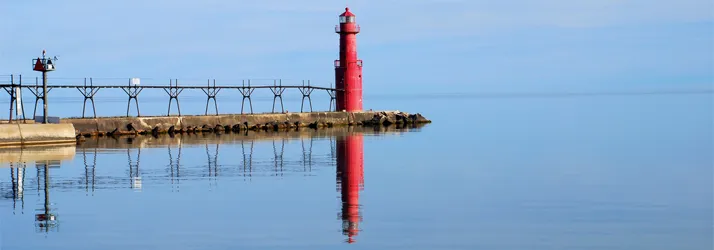Fish Species Found On Lake Michigan
According to the Wisconsin Department of Natural Resources

Lake Michigan and its tributaries support a diverse fish community of both resident and migratory species. Potamodromous salmon and trout were introduced in the 1960's in part to control the explosive population growth of invasive alewife and to provide a sport fishery. These introduced Pacific salmon and trout species such as Chinook salmon, coho salmon, rainbow trout and brown trout have adapted to the new ecosystem and created a major sport and charter fishing industry. The initial stocking of coho salmon occurred in 1966 and Chinook salmon in 1967. These species feed almost exclusively on alewife and help control their abundance (Dettmers et al. 2012). To sustain a successful fishery and balance the predator-prey base agencies around the lake have developed well-planned stocking programs for salmon and trout. The Wisconsin Department of Natural Resources (WDNR) has three egg collection facilities to raise fingerling and yearling fish that are annually stocked in various tributaries (Burzynski 2014).
CHINOOK SALMON (Oncorhynchus tschawytscha)
Common Names: Chinook salmon, king salmon, spring salmon, blackmouth, tschawytscha, chin, king, magnum,
Chinook Salmon are the most sought-after game fish on Lake Michigan.
Identification: Adults are iridescent green to blue‐green on the back and top of the head. The sides are silvery, turning to white on the belly. They have black spots (at least a few) on the upper half of their body and on all fins. Chinook differs from coho salmon and other Great Lakes salmonids by having grey or black mouth coloration with teeth set in black gums, a squared tail with spots on both halves and 15‐19 rays in the anal fin.
Wisconsin State Record Chinook: 44lbs 15oz (Lake Michigan)
COHO SALMON (Oncorhynchus kisutch)
Common Names: Coho salmon, coho, silver salmon, blueback, sea trout
Coho Salmon is known for being some of the best table fair on Lake Michigan.
Identification: Adults are steel‐blue to slightly green on the back, brilliant silver on the sides, and white on the belly. There are small black spots on the back, sides above the lateral line, base of the dorsal fin,
Wisconsin State Record Coho: 26lbs 1.9oz (Lake Michigan)
Steelhead
and rainbow trout are essentially the same species of fish. Steelhead is the name given to the silver ocean-going form of this species. This species is native to the western U.S. where steelhead inhabit the coastal waters and rainbow trout live in rivers, streams, and lakes. Steelheads undergo a process called smolting during which they change physiologically to adapt to life at sea. This change usually occurs when the fish is 7‐8 inches long and 1‐3 years old. Soon after the fish "smolts" it goes out to sea where it lives for 2‐4 years before returning to spawn in the river it was hatched in. Unlike coho or chinook salmon, it doesn't die after spawning but returns to the sea. A steelhead may spawn several times, although most only spawn once or twice. Lake Michigan steelhead live a life that is very similar to that of their ocean-going relatives. The lake serves as a substitute for the ocean and they return to spawn in its tributary streams. Wisconsin is presently stocking three strains of steelhead in Lake Michigan. The spawning migration of each strain occurs at a different time of the year, which makes fish available to anglers for an extended season.
- Skamania Summerrun Steelhead: This strain was developed at the Skamania hatchery in Washington. Wisconsin originally obtained eggs from Indiana, but we now take eggs from adults returning to our streams. The spawning migration (known as "the run") begins in late June and early July. The good stream fishing doesn't begin until the water temperatures start to cool, usually in mid‐September. Spawning occurs from mid‐December through mid‐March with the peak occurring in January and February. The majority of spawning fish are four and five-year-olds. Four-year-old fish average 28 inches and 8 pounds while five-year-old fish average 32 inches and 12 pounds.
- Chambers Creek Winterrun Steelhead: This strain originated at Washington's South Tacoma Hatchery. Eggs for our program were originally obtained from the New York State Department of Environmental Conservation. The spawning migration starts in late fall and continues through winter and early spring. Some of the best stream fishing is from mid‐November through December and again in March and early April. The majority of spawning adults are three and four-year-old fish. Three-year-olds average 25 inches and 6 pounds while four-year-olds average 29 inches and 9.5 pounds.
- Ganaraska River Winterrun Steelhead: This strain originated on the west coast and has since become naturalized in Lake Ontario. It uses the Ganaraska River on the north shore of the lake for spawning. Although referred to as a spring‐run fish in Ontario, the Ganaraskas stocked in Lake Michigan also contribute to the fall and winter stream fishery. Strong pulses of these fish run up the rivers from November to December and again from late March through April. Peak spawning time extends from April to early May. This is the last strain to leave the stream and has extended the fishing opportunities an extra 2 to 4 weeks. Returning adults average 23 inches at age 3 and 26 inches at age 4.
Wisconsin State Record Steelhead: 27lbs 2oz (Lake Michigan)
LAKE TROUT (Salvelinus namaycush)
Common Names: Lake trout, laker, grey trout, Mackinaw, Great Lakes trout
Identification: Lake trout are distinguished by having a deeply forked tail, the inside of their mouth white, and 10‐11 rays in their anal fin. The color of the lake trout varies from light green or grey to dark green or almost black with light spots and worm‐like markings on their back and sides.
Wisconsin State record Lake Trout: 47lbs (Lake Superior)
BROWN TROUT (Salmo trutta)
Common Names: Brown trout, German brown trout, German trout, Eupean brown trout, brownie, brown
Identification: Brown trout caught in Lake Michigan have an overall slivery color with "X" shaped marking on the back and upper half of their body, a squared tail, small and numerous spots on their head, the inside of their mouth white, and 12 or less rays in their anal fin. Spawning brown trout in September and October will have an overall tan to reddish-brown color with distinctive black and red spots.
Wisconsin State record Brown Trout: 41lbs 8oz (Lake Michigan)
BROOK TROUT (Salvelinus fontinalis)
Common Names: Brook trout, Eastern brook trout, speckled trout, brookie, brook, coaster
Identification: Brook trout are identified by having an elongated and compressed body, a squarish tail, and wormlike markings on their back and head. Their color is dark green or brown on their back, lighter colored on their sides, and silvery to white on their belly. They have many light spots on their sides along with red spots surrounded by bluish halos. The lower fins are red with a characteristic white leading edge followed by a black border.
Wisconsin State record Brook Trout: 10lb 1oz (Lake Michigan)
OUR LOCATIONS:
Algoma WI
(800) 446-8605
Sturgeon Bay WI
(800) 446-8605
Winthrop Harbor IL
(800) 446-8605

